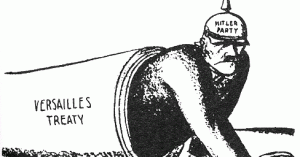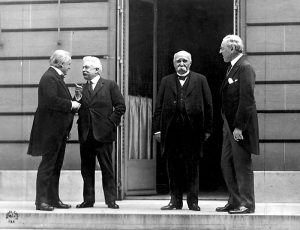Was Adolf Hitler Woodrow Wilson’s “love child?” Retweet
By Perry Willis
We’ve been reviewing U.S. wars and interventions. Here’s what we’ve covered so far…
- Were early U.S. wars good or bad?
- Did Teddy Roosevelt co-found the Japanese empire?
- Did U.S. politicians choose the more evil side in World War 1?
- How U.S. politicians helped create the Soviet Union
Now comes…
Did U.S. policies help create Nazi Germany?
I think the answer is yes. Two things were key… 
- The harsh Versailles Treaty imposed on Germany as a result of U.S. intervention in WW1
- The global Great Depression caused by the Federal Reserve’s monetary policy
One U.S. politician was complicit in both things — Woodrow Wilson!
President Wilson…
- Signed the bill creating the Federal Reserve in 1913
- Made it possible to impose unjust surrender terms on Germany by giving an undeserved victory to Britain and France.
The Importance of the Versailles Treaty
Everyone agrees that the Versailles Treaty helped spark both the Nazi Party and World War 2. This isn’t controversial. But a quick look at the 25-point Nazi Party program drives home the claim. The first two points dealt directly with the Versailles Treaty…
Point #1: We demand the unification of all Germans in the Greater Germany on the basis of the people’s right to self-determination. (The Versailles Treaty cut off some ethnic Germans in the Sudetenland and the Polish Corridor.)
Point #2: We demand equality of rights for the German people in respect to the other nations; abrogation of the peace treaties of Versailles and St. Germain.
Responsibility for the Versailles Treaty lies primarily on Woodrow Wilson. His intervention in the war made the treaty possible, and his 14-points gave support to the crushing reparations payments the treaty imposed on Germany. The economic impact of those reparations gave the Nazi Party its first surge of support.
The Great Inflation
Germany had to pay its war reparations somehow. Inflation was one of their strategies. They started dramatically inflating their currency in June 1921. The inflation reached its peak in 1924. That was also when the Nazis ran their first election campaigns. You can see from the vote totals how they started strong when the inflation was high, but faded as the inflation ended…
- May 4, 1924: The Nazis received 6.5% of the vote and 32 seats out of 472 in the Reichstag.
- December 7, 1924: Nazi votes dropped to 3% and 14 Reichstag seats (out of 493).
- May 20, 1928: Nazi votes dropped to 2.6% and 12 seats (out of 491).
So how did the Nazis gain total power a mere five years later?
The Federal Reserve and the Great Depression
Woodrow Wilson signed the Federal Reserve Act into law on December 23, 1913. Its purpose was to…
- Provide a stable currency
- Protect banks from economic shocks
- End banking panics, recessions, and depressions
The Fed failed to maintain a stable currency almost immediately. It massively increased the money supply to fund the U.S. war effort in 1917/18. This produced some of the worst price inflation ever recorded in America. This inflation devalued savings and threatened retirement incomes. So…
The Fed contracted the money supply to absorb the extra currency it had created during the war. This move protected retirees by restoring the old value of the dollar. The Fed’s governors knew this action would also cause a depression. They were willing to accept that outcome because they believed rapidly falling prices would quickly restore prosperity. They turned out to be correct.
The 1920 depression lasted only a few months. James Grant tells the story in his great book, The Forgotten Depression. The 1920 depression teaches us four lessons…
- The Fed can cause price inflation by expanding the money supply
- The Fed can make prices drop by contracting the money supply
- Contracting the money supply can cause a depression (as it did in 1920 and again between 1930 and 1933)
- The depression can be short-lived if prices are allowed to fall in concert with the shrinking money supply
Understanding these points from the 1920 depression will help you see how Fed policies between 1929 and 1933 led to the rise of the Nazis. Let’s look at this story step-by-step…
First came the Roaring Twenties boom
It appeared as if the Fed was finally doing a good job of maintaining a stable currency — net price inflation for the decade was zero (as measured by current methods). But looks can be deceiving…
Economist Murray Rothbard argued that the money supply was actually rising in the late 1920s. This may not have been reflected in general prices yet, but it was surely evident in stock prices. Economist Friedrich Hayek noticed this at the time. He wrote a paper in February 1929 predicting that the Federal Reserve’s monetary expansion would lead to a crisis starting in the stock and credit markets.
And then came the bust
Hayek’s stock market prediction came true eight months later when the U.S. stock market crashed on October 29. But it’s what the Federal Reserve did next that really hurt…
The Fed shrank the money supply by one-third between 1929 and 1933!
The result was the same as in 1920 — a deep depression.
Why did the Fed do this? It isn’t clear. There was no need to counteract price inflation as there had been in 1920. But what really matters is this…
- The result was a deep global depression
- The time period during which the money contraction happened was crucial — 1930 to 1933
It’s been said in various ways by various people…
“When America catches a cold, the world catches the flu.”
The U.S. is so large and powerful that everything it does impacts the world in a magnified way. That’s why, when the Federal Reserve crashed the U.S. money supply between 1930 and 1933 the resulting depression spread around the globe, including to Germany.
And the date range when the money contraction happened is the precise time during which the Nazis went from tiny to huge. You can see the change in the Nazi’s vote totals…
- September 14, 1930: The Nazis received 18.3% of the vote and 107 seats in the Reichstag (18.5% of 577 seats).
- April 1932: Nazi Party membership reached 800,000 card-carrying members.
- August 31, 1932: The Nazis received 37.3% of the vote and 230 seats (37.8% of 608 seats). This election made the Nazi’s the largest party in the Reichstag.
- November 6, 1932: The Nazis received 33.1% of the vote and 196 seats (33.5% of 584 seats). Support for the Nazis had fallen a bit, but they remained the largest party in the Reichstag. It’s normal in a parliamentary system for the largest party to gain control of most government ministries. Therefore, it was only a matter of time before the Nazi’s leading position in the Reichstag resulted in the acquisition of executive power, and so…
- January 30, 1933: President Hindenburg appointed Hitler as Chancellor, giving him ministerial control of the government.
- March 5, 1933: The Nazis received 43.9% of the popular vote and 288 seats in the Reichstag (44.5% of 647 seats). The Nazi’s now had full control of Germany, with everything that would come to mean for the world.
The U.S. roots of Nazi power
Follow the chain of cause and effect…
- U.S. intervention in WW1 gave victory to Britain and France, and imposed the Versailles Treaty on Germany.
- The Versailles Treaty midwived the Nazi Party
- Federal Reserve policies gave the Great Depression to the world and power to the Nazis
Now run the story another way. Remove the U.S. intervention in WW1, the Versailles Treaty, and the Federal Reserve. If none of those things had happened then…
The Nazis would’ve remained a tiny party of nut jobs, barely a footnote in history.
We’ve covered how U.S. policies helped create the Soviet Union and Nazi Germany. The next article in this series will show how U.S. involvement in WW1 helped create radical Islam.
Thank you for being an ACTIVE DC Downsizer. If you like our work please consider making a contribution or starting a monthly pledge here.
Perry Willis
Co-founder, Downsize DC
Co-creator, Zero Aggression Project
PS: Please remember the three points I am trying to demonstrate with these articles…
- Our “patriotic holidays” need to honor soldiers without mischaracterizing U.S. wars.
- The claim that U.S. soldiers “defended our freedom” is sweet-sounding but false. Freedom may be what our soldiers wanted to defend, but that’s not how our politicians actually used them.
- We must curtail the future ability of politicians to aggress against foreign countries.
Please also remember this crucial point — I’m not blaming America for anything, but I am blaming U.S. politicians for lots of things.
PPS: Here’s a list of books consulted in this series.
If you buy these books and using the links we’ve provided, Downsize DC will get credit we can use to expand our research library. Thank you for your interest and support.
The rise of Nazi Germany
The Forgotten Depression by James Grant
America’s Great Depression by Murray Rothbard
A Monetary History of the United States by Milton Friedman and Anna Schwartz
Paris 1919 by Margaret Macmillan
The Russian Revolution
Comrades by Brian Moynahan
Russia Leaves the War by George F. Kennan
World War 1
The Illusion of Victory by Thomas Fleming
World War I by Richard Maybury
The Pity of War by Niall Ferguson
The Forgotten Depression by James Grant
The Spanish-American War, the conquest of the Philippines, and Teddy Roosevelt’s betrayal of Korea…
Bully Boy by Jim Powell
The Politics of War by Walter Karp
The War Lovers by Evan Thomas
Honor in the Dust by Gregg Jones
The Imperial Cruise by James Bradley
The Mexican War
A Wicked War by Amy S. Greenberg


